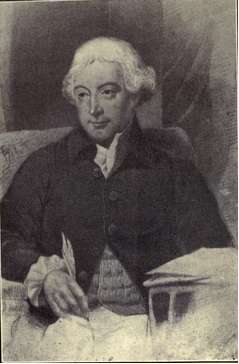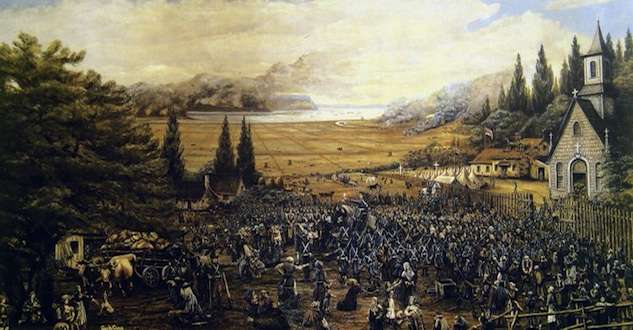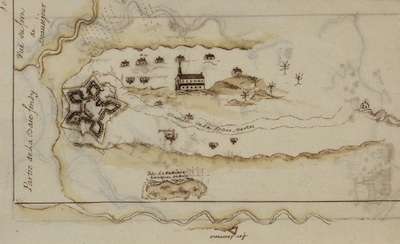For nearly 40 years in the early 18th century, Acadian farmers in Canada refused orders to take an unconditional oath of loyalty to the British Crown. Since there were far more Acadians than British military forces, the Acadians got away with it.
The British had taken Acadia in 1710 as part of their continuing struggle with the French to dominate North America. At the end of Queen Anne’s War, fought largely in Maine, Massachusetts and Nova Scotia, Britain won the southern part of Nova Scotia in the Treaty of Utrecht.
The British didn’t have much of a presence in the region, though. That allowed the French to encroach by building two forts in what is now New Brunswick: Beausejour, in Aulac, and Gaspareaux, near Port Elgin.
But in June 1755, France’s Fort Beausejour fell to the British and Gaspareaux surrendered without a fight. Shortly thereafter, acting Gov. Charles Lawrence ordered the Acadians to take the loyalty oath. This time, the British could back up their orders with force, because three regiments and New England Ranger units had arrived.
But the Acadians did not want to pledge allegiance to a Protestant monarch and forswear their loyalty to the pope.
Acadians Refuse Loyalty Oath
By 1755, decades of fighting with the French and Indians left the British fed up with Acadian intransigence. Dummer’s War followed Queen Anne’s War, and King George’s War followed in 1744. The Catholic Acadians scattered throughout the region were ostensibly neutral during these conflicts.
But some waged guerilla war against the British with their allies, the Wabanaki and the Micmac people, who were also Catholic.
Halifax
In 1749, the British tried to tighten military control over Nova Scotia. They built forts in the most important Acadian communities in Nova Scotia and New Brunswick. They also provoked the Micmac people by founding the Protestant settlement of Halifax, a violation of their treaty with the Indians.
The founding of Halifax touched off Father Le Loutre’s War. Acadian and Micmac forces attacked Halifax in at least half of the 24 battles, raids and skirmishes of the conflict. The French also built their own forts, including Fort Beausejour on the border between Nova Scotia and Acadia.
Father Le Loutre was joined by an Acadian resistance fighter, Joseph Broussard, known as Beausoleil. In 1750, Le Loutre led many Acadians and Micmacs to new homes in unsettled regions controlled by the French: Chignecto, Prince Edward Isle and Cape Breton. The British called him Moses.
The Final British Push
The British began their final push against the Acadians in Canada on June 4, 1755, when Lt. Col. Robert Monckton began to move toward Ft. Beausejour. He led 2,400 men: three British regiments and New England Ranger units led by Joseph Gorham of Yarmouth, Mass.
The 400 French, Acadian and Micmac men were no match for the combined British and New England forces that laid siege to the fort. A cathedral next to Fort Beausejour had just been finished a month before the British laid siege. Father Le Loutre ordered it burned so the British wouldn’t occupy it. He saved the cast-iron bell, still at the site of the fort, now a National Historic Site of Canada.
The fort surrendered on June 16. British troops moved on to force the other French forts in the region to capitulate.
Acadian Expulsion
Two weeks after the fall of Fort Beausejour, Lawrence ordered the forcible removal of the entire Acadian population from Nova Scotia, New Brunswick, Prince Edward Island and parts of what is now Maine. Estimates vary, but the British rounded up as many as 10,000 Acadians out of a population of 12,000. Then they boarded them onto ships and sent them to the 13 British colonies in North America and to France. Several thousand died of disease, starvation and drowning.

Charles Lawrence
The British seized their farms and livestock, pillaging and burning their homes to make sure they wouldn’t return.
Father Le Loutre escaped to Quebec and sailed to France, but the British captured him on the journey and imprisoned him for eight years. After his release, he tried to help Acadians deported to France. He died Sept. 30, 1772 in Nantes, France, leaving his worldly possessions to the expelled Acadians.
Henry Wadsworth Longfellow wrote a poem about the expulsion of the Acadians, called Evangeline. Beausoleil led a group to settle in Louisiana. One of his descendants is a performing artist known as Beyonce.
This story was updated in 2023.





19 comments
it’s all in “Evangeline”… the arcadians were thrown out, as our european and british leaders wished, and they ended up in Louisiana, where they are to this day, called “Cajuns”…. people who know the swamps and live there… and pretty much know New Orleans and everything around it. how sad to know that history repeats itself so many times…. shameful, we are.
In French it’s called le Grand Derangement. Other Acadians escaped to New Brunswick and some ended up in the Madawaska region of the St. John River Valley. The Acadians gather every 5 years to celebrate their heritage. This year’s Acadian Congress will be held in the Madwaska region of Northern Maine and New Brunswick. See the link to its website http://www.cma2014.com/en/ My mother’s family is descended from these Acadians.
Le Grand Derangement – n’oubliez jamais……
The previous summer in 1754, Captain Winslow led his men up the Kennebec River in Maine to build Fort Halifax and Fort Western in modern day Winslow and Augusta, respectively. It was at the start of the French and Indian War that began at Fort Duquesne, modern day Pittsburg, not long before. In the summer 1755 Winslow evicted the Acadians from Grand Pre, both events under orders from Governor Shirley of Massachusetts.
My Great ancestor [Renee Leblanc, Note republic of Grand Pre, is mentioned in in Longfellow’s poem, “Evangeline” and the book “A Great and Noble Scheme”
Renee Leblanc, Grande Pre’s town clerk is a grandfather in my direct line. My Cyr line escaped the British by going to Grande Pre, and, Madawaska. Tante Blanc is also one my grandmothers. My earliest anscestor arrived in 1628, Pierre Cyr.
Don’t be mistaken on this. Some signed but were deported just the same. By signing they were relinquishing their rights to their languages, religion and their country. It wasen’t straight forward as the article appeares.
My family, descendants of Antoine Bourg who arrived in Acadia in the early 1640’s, still reside in the same area where he settled, around Beausejour. After all this time we never went away. We kept our language and religion. So many present day Acadian families in NB, PEI and NS have the same story. Vive l’Acadie!!
The spirit lives on in the Cajun music of the wonderful groups Beausoliel, and , locally (Maine), Vent du Nord
[…] British had kicked out about 11,000 Acadians in 1755 after the French surrendered their forts at Beausejour and Gasparaeux. They were eager to […]
[…] of the problems facing the French. The news reached New England that D’Anville had arrived in Nova Scotia – but the condition of his fleet was not […]
My ancestor Joseph Gueguen was with Le Loutre prior to the expulsion (Le Grande Dérangement) and related to the priest Manach who was employed by Le Loutre. A great book of the history of this period is titled “A Great and Noble Scheme”, by John Mack Farragher. Vive L’Acadie!
Thank you for the suggestion! We’re always looking for good books on Franco-American history.
[…] Source 2 (new england historal society) […]
[…] When the French built two forts in nearby New Brunswick. Shirley began recruiting forces to kick them out of Acadia. Troops that left Boston in May captured Fort Beausejour in June. […]
[…] in French Canada, the “Judas of Arcadia” sold out French Canadian interests to the English in Father Le Loutre’s War and so been forced to retire to London. Here he managed to beguile de Beaumont, parking himself in […]
[…] didn’t all come at once. Some were expelled by the British in the Great Roundup of 1755. Some fled the fighting between the French and British in the Patriots Rebellion of […]
[…] 1900, Woonsocket was 60 percent French-Canadian, one of the most French cities in America. The French were Quebecois farmers who came to work in […]
[…] facing the French. The news reached New England that the Duc D’Anville had arrived in Nova Scotia – but the condition of his fleet was not […]
Comments are closed.